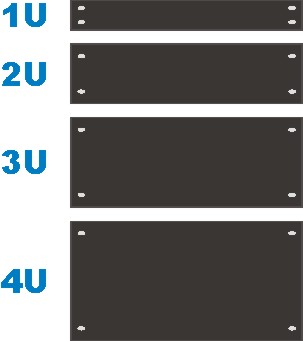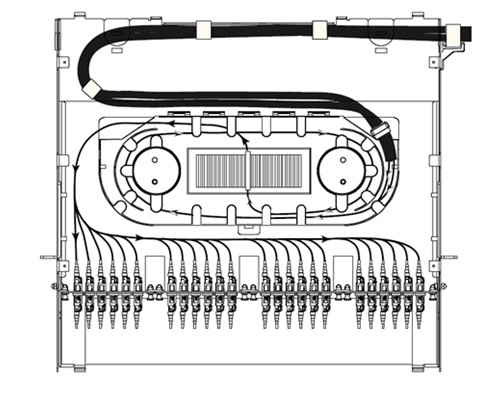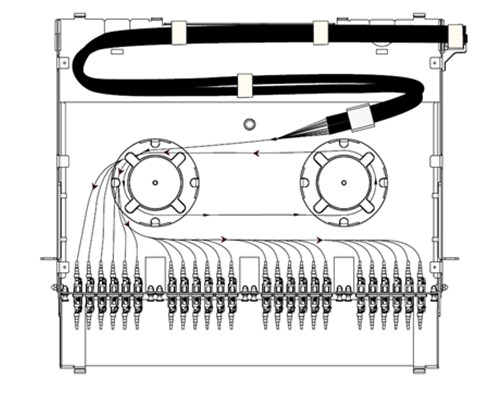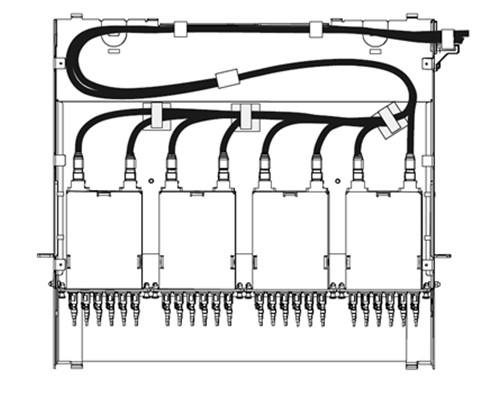Fiber enclosure is a vital component that often used to organize cables and protect fibers in fiber optic cabling and terminations. And it is extensively used in specific fields like data centers, server rooms, FTTX, CATV and so forth. Since data center configurations and requirements can be various, different types of rack mount fiber optic enclosure are designed to meet those special needs. The right fiber enclosures can effectively boost network performance, enhance working efficiency and reduce expenditure. So here we will introduce several types and designs of rack mount fiber enclosures and offer some suggestions on how to select the right one.
As one of the most commonly used fiber enclosures in data center, rack mount fiber enclosure provides a convenient and rugged termination point for fiber jumper cables. This rack mount enclosures offer a flexible connectivity system using a variety of adapter plates and MPO cassettes.
The rack mount fiber enclosure is generally made for standard 19 inch rack mounting. Depending on the number of connections required, they are available in one or more rack units (RU) height configurations, such as 1RU, 2RU or 4RU, etc. The following picture shows the different size of enclosure configuration, and according to it, you could choose the most proper one depending on the space and requirements of your project.

Generally, there are three types of rack mount enclosures: fiber enclosure with a removable lid, slide-out fiber enclosure and swing-out type enclosure. The slide-out type and swing-out type is generally more expensive than the cover removable type, but with these two designs, you can benefit a lot during cable installation and maintenance, since you do not need to remove the whole enclosure from the rack to gain internal access. It is proved to be time and energy saving.

As for the design of the fiber enclosures front panel, there exist fixed front panel and removable front panel. The fixed front panel can be loaded with appropriate fiber optic adapters, while the removable front panel can accommodate several fiber optic adapter panels or cassettes. Nowadays, the removable front panel is becoming more popular because a plug & play fiber adapter panel assures flexibility and ease of network deployment.

Basically, rack mount fiber enclosures can be used in the following three circumstances.
For fiber splicing joints in fiber enclosures, splice tray and FAPs are needed. When installing four fiber adapter panels on the front panel and one or more splicing trays inside the enclosure drawer, this fiber enclosure can provide cable management and protection for splicing joints and connections.

This kind of fiber enclosure usage is very common. Simply by installing two slack spools and four fiber patch panel on the fiber enclosure, it could make fiber patch cables management much easier. The following picture shows a breakout fiber patch cable installed in the fiber enclosure and being well organized by the spools.

The popularity of 40G/100G network makes the transferring between 40G/100G MTP interfaces and 10G LC interfaces an important issue. MTP cassettes are widely used to reduce installation time and ensure the connection quality. A 1U rack mount fiber enclosure can hold up to 4 HD MTP cassettes. The picture below shows the fiber enclosure with four HD MTP cassettes which are connected by several input MTP trunk cables.

In this part, we will solve the problems that troubled some data center operators—how to choose the most suitable rack mount fiber enclosure. Here we offer a reference guide for you to follow.
First, list all the requirement of the enclosure and the complete measurements: height, depth, width, and weight, which will ultimately determine what type of rack mount fiber enclosure you need. Note that always select a bigger fiber enclosure for all your existing equipment and for future growth.
A fiber enclosure should provide plenty of access points through the rear and top of the cabinet, as well as through the bottom for raised floor installations. Not only are the fiber optic cables mounted in the fiber enclosure, but devices like hubs, routers, patch panels, and monitors are needed to be mounted in the enclosure-network. Remember that any accessories that are not rack-mountable will require additional trays, shelves and mounting accessories.
Choosing an affordable rack mount fiber enclosure that within your installation budget serves as a basic requirement. We sometimes are stuck in a dilemma that whether to choose an equipment optimum for now or the expensive one for future. However, a premium rack mount fiber enclosure is a durable item that will provide services for years to come.
Rack mount fiber enclosure has become increasingly popular in data centers to ensure better cable management and maintenance. Besides, it can also be employed for fiber splicing joints, patch cord connections and MTP to LC interface transferring. Since several types and designs are available, just making the choice based on your specific need, then take the physical demand, accessories and budget into consideration. For more information and details about fiber enclosure, please visit www.fs.com.




